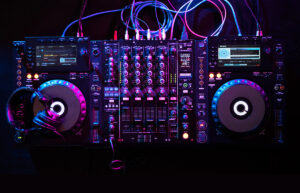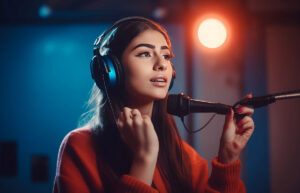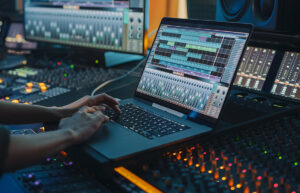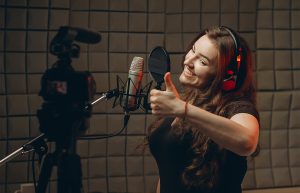Become A Voiceover Artist : Meaning, Types, Skills, Equipments & Steps

Are you ready to uncover the secret of how to become a voiceover artist? Let’s explore the world of voiceover artistry together. Close your eyes, take a deep breath, and imagine your voice bringing vivid scenes to life, embodying characters and captivating audiences. This guide delves into the role of a voiceover artist, opportunities in the field, and much more.
Welcome to TheDemoStop, now join the community!
Connect with artists, fans and producers around the world.
What is voice over?
Voice over, often abbreviated as VO, is the process of recording spoken dialogue or narration that accompanies visual content, such as films, TV shows, commercials, animations, video games, audiobooks, and more. It’s a versatile form of performance art that requires skill in interpretation, vocal control, and the ability to adapt to various styles and genres.
Who is a voice over artist?
A voice over artist is a skilled professional who provides their voice for various forms of media, such as commercials, animations, films, audiobooks, video games, and more. They use their vocal talents to convey emotions, deliver information, and portray characters, often without appearing on screen themselves.
Voiceover artists can bring scripts to life through their interpretation, tone, and delivery, making them essential contributors to the entertainment industry.
Type of voice acting work
Commercials
Voice actors lend their voices to radio, television, and online advertisements promoting products or services. They need to deliver the message clearly, engagingly, and memorably within a short timeframe. Commercial voice acting work often involves conveying emotions that resonate with the target audience and align with the brand’s image.
Animation
Voice actors breathe life into animated characters in television shows, films, web series, and short films. They create unique voices and personalities for characters, bringing them to life through expressive performances. Animation voiceover work often requires versatility in portraying various ages, gender species (for non-human characters), and personalities.
Video Games
Voice actors provide voices for characters, narrators, and announcers in video games across different genres, including action, adventure, role-playing, and simulation. They may perform dialogue for protagonists, antagonists, side characters, and non-playable characters (NPCs), contributing to the immersive gaming experience. Video game voice over work can involve recording lines for cutscenes, in-game dialogue, tutorials, and interactive prompts.
Audiobooks
Voice actors narrate books, novels, and other literary works in audio format, allowing audiences to listen to stories while on the go. They use their vocal talents to convey the written text’s tone, atmosphere, and emotions, capturing the essence of the author’s storytelling. Audiobook narration requires pacing, clarity, and the ability to maintain listener engagement throughout the duration of the recording.
Multimedia
Voice actors contribute to various multimedia projects, including corporate videos, presentations, training modules, and explainer videos. They provide narration, character voices, and voiceovers for instructional content, documentaries, promotional videos, and more. Multimedia voice over work spans various industries and applications, catering to diverse audiences and purposes.
Movies
Voice actors may perform additional dialogue replacement (ADR) for live-action films, dubbing over actors’ lines in post-production to improve clarity or accommodate language differences. Movie voiceover work encompasses a variety of genres, including animated films, documentaries, foreign language films, and voiceover narrations for film trailers and promotional materials.
Skills required for a voice over artist
Versatility
To become a voice over artist, people need to adapt their voice to suit a wide range of characters, tones, styles, and genres. They should be able to switch between different accents, dialects, ages, genders, and vocal qualities to meet the requirements of various projects. Versatility enables voice actors to handle diverse roles and effectively portray characters with authenticity and depth.
Creativity
Voiceover artists must be creative in interpreting scripts and bringing characters to life through their vocal performances. They should be able to infuse personality, emotion, and nuance into their delivery, making the characters memorable and engaging for the audience. Creativity allows voice actors to explore different vocal techniques, improvisations, and approaches to enhance the storytelling and communication of the script.
Articulation
Clear and precise articulation is essential for voiceover artists to ensure that the audience easily understands their dialogue. They should have excellent diction, pronunciation, and enunciation, avoiding mumbling, slurring, or swallowing words. Articulation enables voice actors to convey the intended message accurately and effectively, regardless of the complexity of the script.
Strong work ethics
Voiceover artists need to demonstrate professionalism, reliability, and dedication in their work. They should meet deadlines, follow instructions, and communicate effectively with clients, directors, and production teams. Strong work ethics involve maintaining a positive attitude, being flexible and adaptable, and continuously striving for excellence in performance and professionalism.
Welcome to TheDemoStop, now join the community!
Connect with artists, fans and producers around the world.
Experience
While not always a prerequisite, experience in voice acting can provide valuable insights, skills, and techniques that enhance performance. Voiceover artists can gain experience through formal training, workshops, practice sessions, and working on various projects. Experience allows voice actors to develop their craft, refine their skills, and build a portfolio of work that showcases their talent and versatility.
Consistency
Voice actors should deliver consistent vocal tone, energy levels, and characterizations throughout the recording session or project. Consistency ensures that the audience remains engaged and immersed in the story, creating a cohesive listening experience across the entire production.
Equipment required for voice over
A computer and software

A computer is essential for recording, editing, and managing voiceover projects. To become a voiceover artist, people typically use digital audio workstation (DAW) software, such as Adobe Audition, Pro Tools, Audacity, or Reaper, to record and edit audio files.
A microphone

A high-quality microphone is the most crucial piece of equipment for voiceover work. Condenser microphones are commonly used for voiceover due to their sensitivity and ability to capture clear, detailed sound.
An audio interface

An audio interface is necessary for connecting the microphone to the computer and converting analog audio signals into digital data that can be recorded and processed. It provides preamplification, phantom power, and input/output connections for microphones, headphones, and speakers.
A pair of headphones

High-quality headphones are essential for monitoring audio during recording and editing sessions. Closed-back headphones are preferred for voiceover work as they provide isolation from external noise and prevent sound leakage into the microphone.
A pop filter or shield

A pop filter or shield is used to minimize plosive sounds (such as “p” and “b” sounds) and reduce air blasts from the mouth hitting the microphone. Pop filters are typically made of nylon mesh or metal and attach to the microphone stand or mount.
Reliable internet access
While not directly related to recording equipment, reliable internet access is essential for voiceover artists who collaborate remotely with clients, directors, or production teams. Voiceover artists may also need internet access for research, script delivery, and promotional activities related to their work.
How to become a voiceover artist
Work on your craft
Take acting classes, voice lessons, and workshops to develop your vocal skills, performance techniques, and emotional range. To become a voice artist, practice reading aloud, improvising, and interpreting scripts to hone your delivery and expression. Record yourself reading scripts, monologues, or character lines to analyze your performance, identify areas for improvement, and track your progress over time.
Gain acting skills and experiences
Build your acting chops by participating in local theater productions, community projects, or student films. Learn to embody characters, convey emotions, and deliver believable performances through acting exercises and scene work.
Practice consistently
Dedicate regular time to practice voice acting exercises, warm-ups, and vocal drills to strengthen your voice and improve your skills. Being consistent in practice will increase your command over delivery.
Find your niche
Explore different genres, industries, and types of voiceover work to discover where your strengths and interests lie. Identify your unique voice qualities, specialties, and areas of expertise that set you apart from other voice actors.
Record a demo reel
Create a professional demo reel showcasing your vocal range, versatility, and ability to perform various types of voiceover work. Select a variety of samples that highlight your skills in narration, character acting, commercial readings, and any other specialties in which you excel.
Network in your industry
Attend voiceover conferences, workshops, and events to connect with industry professionals, learn from experienced voice actors, and stay informed about industry trends and opportunities. Join online forums, social media groups, and networking platforms for voice actors to share experiences, exchange advice, and collaborate on projects.
Welcome to TheDemoStop, now join the community!
Connect with artists, fans and producers around the world.
Salary and job outlook for voice over artists
The average salary of a voice over actor is $31,500 per year. However, a newbie voice over actor can expect $18,400 per year, and it’s $90,500 per year for an experienced voice over actor. The renowned voice over actor can earn up to six figures.
Despite competition, the demand for voiceover work is growing across industries like advertising, entertainment, and gaming due to the rise of digital media platforms and audiobooks. Talented voice actors who deliver quality performances consistently can expect steady work and opportunities for career growth.
Conclusion
What is voice over?
Voice over is the recorded spoken dialogue or narration accompanying visual content in various media such as films, TV shows, commercials, animations, video games, and audiobooks.
Who is a voiceover artist?
A voiceover artist is a professional who provides their voice for various forms of media, including commercials, films, video games, and more. They use their vocal talents to convey emotions, deliver information, and portray characters.
Types of voice acting work
- Commercials
- Animation
- Video games
- Audiobooks
- Multimedia
- Movies
Skills required for a voice over artist
- Versatility
- Creativity
- Articulation
- Strong work ethics
- Experience
- Consistency
Equipment required for voice over
- A computer and software
- A microphone
- An audio interface
- A pair of headphones
- A pop filter or shields
- Reliable internet access
How to become a voiceover artist
- Work on your craft
- Gain acting skills and experiences
- Practice consistently
- Find your niche
- Record a demo reel
- Network in your industry
Salary and job outlook for voiceover artists
The average salary of a voice over actor is $31,500 per year. Talented performers can expect steady work and opportunities for growth.
FAQs
What is voice over?
Voice over is recorded spoken narration accompanying visual content in various media such as films, TV shows, commercials, animations, and audiobooks.
Who is a voiceover artist?
A voiceover artist is a professional who provides their voice for various media productions, including commercials, animations, audiobooks, films, and video games.
How do I become a voiceover artist?
- Work on your craft
- Gain acting skills and experiences
- Practice consistently
- Find your niche
- Record a demo reel
- Network in your industry
What are the types of voice acting works?
- Commercials
- Animation
- Video games
- Audiobooks
- Multimedia
- Movies
What is the role of a voiceover artist?
The role of a voiceover artist is to provide recorded spoken dialogue or narration that accompanies visual content in various media productions, such as commercials, animations, films, audiobooks, and video games.
Which skills are required to become a voiceover artist?
- Versatility
- Creativity
- Articulation
- Strong work ethics
- Experience
- Consistency
What are the benefits of becoming a voice over artist?
The benefits of becoming a voice over artist include flexible work schedules, creative fulfillment, the potential for steady income, opportunities for growth and diversification, and the ability to work remotely.
How much do voiceover artists get paid?
The average salary of a voice over actor is $31,500 per year, depending on their talent and demand in the industry.

































































